APRIL 2016
Emerging Science and Technology
Trends: 2016-2045
A Synthesis of Leading Forecasts
Office of the Deputy Assistant Secretary
of the Army (Research & Technology)
�
DISCLAIMER
This report was prepared for the Deputy Assistant Secretary
of the Army (Research & Technology) by FutureScout, LLC, a
strategy and analytics firm specializing in helping organizations
understand emerging trends and how to prepare strategically
to thrive in the face of an uncertain future. Questions regarding
the preparation of this report may be directed to:
Dr. Jason Augustyn
President, FutureScout LLC
(571) 730-0992
jason@futurescoutllc.com
This report was prepared as an account of work sponsored by
the United States Army. Neither the United States Army nor any
component thereof, nor any of its contractors or subcontractors
makes any warranty for the accuracy, completeness, or any
third party’s use of the information contained herein. Reference
herein to any specific commercial product, process, or service
by trade name, trademark, manufacturer, or otherwise, does not
necessarily constitute or imply its endorsement, recommendation,
or favoring by the United States Army or any component
thereof or its contractors or subcontractors. The views and
opinions of authors expressed herein do not necessarily state
or reflect official views or policies of the United States Army.
�
TABLE OF CONTENTS
EXECUTIVE SUMMARY .....................................................................1
BACKGROUND ..................................................................................2
EMERGING S&T TRENDS .................................................................3
CROSS-CUTTING THEMES...............................................................9
CONCLUSION ................................................................................... 12
APPENDIX A: BIBLIOGRAPHY ...................................................... 14
APPENDIX B: ANALYSIS METHODS ............................................. 16
TREND CARDS .................................................................................18
ODASA(R&T) | Emerging S&T Trends: 2016-2045�
EXECUTIVE SUMMARY
This is the third annual report on emerging trends in science and
technology (S&T) published by the Deputy Assistant Secretary of the
Army for Research and Technology (DASA R&T). As in prior years, the
report has two primary objectives. First, it is intended to inform leaders
across the U.S. Army and stakeholders in the joint, interagency, and
international community about S&T trends that are likely to influence
the future operating environment and shape warfighting capabilities
over the next 30 years. Second, it is intended to spark strategic
dialogue around the kind of S&T investments the Army should make to
ensure that our Soldiers maintain overmatch in future operations.
This 2016 version of the S&T Strategic Trends report synthesizes
32 S&T forecasts that have been published over the past five years
by government agencies in the U.S. and abroad, industry leaders,
international institutions, and think tanks. The objective was to identify
trends that are most likely to generate revolutionary or disruptive
change of interest to the Army over the next 30 years. By consolidating
multiple trend analyses into a single reference document, this report
aims to provide a ready reference for Army leadership as it considers
the important role S&T will play in shaping the future of our Army.
Analysis of the source documents produced 690 individual trends related
to science and technology, as well as trends related to broader contextual
factors that will shape the evolution of S&T over the coming decades. From
this data set, 24 emerging science and technology trends were identified:
• Robotics and
autonomous systems
• Additive manufacturing
• Analytics
• Human augmentation
• Mobile and cloud
computing
• Medical advances
• Cyber
• Energy
• Smart cities
• Internet of things
• Food and water
technology
• Quantum computing
• Social empowerment
• Advanced digital
• Blended reality
• Technology for climate
change
• Advanced materials
• Novel weaponry
• Space
• Synthetic biology
• Changing nature of work
• Privacy
• Education
• Transportation and
logistics
In addition to these emerging S&T trends, this report discusses
six broad contextual forces that are likely to shape the evolution
of science and technology over the next 30 years: urbanization,
climate change, resource constraints, shifting demographics, the
globalization of innovation, and the rise of a global middle class.
As with previous editions of the S&T Strategic Trends report, a set of
“trend cards” are included in this report. These cards provide additional
detail on the S&T trends, including a synopsis of each trend, along
with summaries of enabling S&T domains, recent developments that
signal how each trend might evolve, and a high-level consideration
of the impacts each trend might have on society, politics, economics,
the environment, and defense. These trend cards provide a convenient
reference for trends that have the most potential for influencing
Army capabilities and the future operating environment.
Science and technology are part of a system of driving forces that
will change many aspects of the world over the next 30 years.
While it is impossible to accurately predict the future in detail, the
trends discussed in this report will influence the course of global
change with ramifications for the U.S. Army. The intent behind the
analysis presented here is to inform Army leadership about where
the future might be headed, and by doing so, support strategic
thinking about how best to prepare the force for the road ahead.
Point of Contact
Questions regarding this report should be directed to:
Aaron Chan
(Acting) Director, Technology Wargaming and Manufacturing
Office of the Deputy Assistant Secretary of the Army
(Research & Technology)
ASA(ALT) SAAL-ZT
703-697-0427
aaron.m.chan2.civ@mail.mil
1
ODASA(R&T) | Emerging S&T Trends: 2016-2045�
BACKGROUND
This is the third annual report on emerging trends in science and
technology (S&T) published by the Deputy Assistant Secretary of the
Army for Research and Technology (DASA R&T). As in prior years, the
report has two primary objectives. First, it is intended to inform leaders
across the U.S. Army and stakeholders in the joint, interagency, and
international community about S&T trends that are likely to influence
the future operating environment and shape Army capabilities over
the next 30 years. Second, it is intended to spark strategic dialogue
around the kind of S&T investments the Army should make to ensure
that our Soldiers maintain overmatch in future operations. This report
is part of the DASA R&T’s broader Technology Wargaming program,
which seeks to provide strategic foresight research and analysis
in support of both S&T investment planning and Unified Quest, the
Army’s annual future study program sponsored by the Chief of Staff
and conducted by the Army Capabilities Integration Center (ARCIC).
We stand on the cusp of technological revolutions on multiple fronts, in
fields as diverse as robotics and synthetic biology. Technology has been
central to the American way of war throughout the nation’s history,1
and it is safe to assume that scientific and technological advancements
will remain an important foundation for U.S. Army capabilities over the
next 30 years and beyond. At the same time, the global economic and
political landscape is undergoing the most profound realignment since
the fall of the Soviet Union. The United States military has long relied on
an overwhelming advantage in research, development, and innovation
that is unlikely to persist much longer. As China, Russia, and other
nations modernize their militaries through investments in science and
technology, it will become essential for the U.S. Army to make the most
effective use of S&T investments to stay ahead of emerging threats.
Effective investment strategies start with an understanding of emerging
trends. Therefore, the aim of this edition of the S&T Strategic Trends
report is to identify the major trends in science and technology that are
likely to influence Army capabilities and the future operating environment
over the next 30 years. The approach toward identifying these trends
involved a comprehensive review and synthesis of open source forecasts
published by government agencies in the U.S. and abroad, industry
analysts, think tanks, and academic organizations. These institutions are
also grappling with the influence of S&T on social, political, economic,
environmental, and defense-related issues, and an analysis of the
documents they produce reveals a number of common themes. Rather
than duplicating the numerous S&T-related forecasts conducted by the U.S.
National Intelligence Council, U.K. Ministry of Defense, the McKinsey Global
Institute, and other major organizations, this report seeks to leverage
their collective insights to identify trends that will impact the U.S. Army.
1. Mahnken, T.G. (2010). Technology and the American Way of War Since 1945. NY: Colum bia University Press.
In that vein, a comprehensive literature search was conducted to
identify trend forecasts published by foreign and domestic government
agencies, industry analysts, academic organizations, and think tanks.
A total of 32 reports were selected based on the following criteria:
• All of the reports had to be the product of rigorous and well-
documented research conducted by reputable organizations with a
track record of producing high-quality trend analysis.
• All of the reports had to have been published within the past 5 years.
• All of the reports had to address science and technology trends
that could influence Army operations and the future operating
environment over the next 30 years.
• All of the reports had to address a wide range of science and
technology trends. Narrow forecasts related to highly specific
industries or technology domains were not included in this analysis.
Appendix A provides a complete bibliography of the sources that were
used to conduct this synthesis of emerging science and technology trends.
Overall, 9 sources were carried over from the 2015 Emerging Trends
report, while 23 new sources were added. A content analysis of these
documents (described in Appendix B) identified 690 specific trends related
to science and technology as well as societal, economic, environmental,
and political trends that are likely to shape the context in which scientific
and technological developments will occur. Further analysis of the trend
data revealed 24 common science and technology “mega-trends” that
have the potential to shape future Army operations and the future
operating environment. The analysis also identified six cross-cutting
contextual trends that will influence how science and technology could
evolve. Details on the analysis methodology are presented in Appendix B.
The remainder of this report is divided into two primary sections. The
first section reviews the science and technology trends that were
identified through the synthesis of open source forecasts. As with
the 2015 Trends report, a set of “trend cards” has been prepared that
summarizes each of these trends. The cards, which are appended to
the end of this report, provide a brief synopsis of each trend, review
key scientific and technical enablers of the trend, highlight recent
developments that signal how each trend might evolve over the coming
decades, and review some of the impacts that each trend might have on
society, politics, the economy, the environment, and national defense.
The second section of the report reviews six contextual trends that
appeared as common themes in many of the source documents. These
trends speak to broader undercurrents that will shape the nexus among
S&T, sociopolitical change, and national security through 2045.
2
ODASA(R&T) | Emerging S&T Trends: 2016-2045�
However, while “Big Data” has become a buzzword, less than 10% of data
generated each year ever gets analyzed. Over the next 30 years our ability
to make better use of massive, dynamic data sets will improve. Automated
bots will crawl unstructured data, identifying relationships that are
visualized in immersive virtual datascapes. Analytics will spread beyond
the enterprise, as people gain the ability to apply big data to their personal
lives. Citizens will have the ability to use data to hold governments and
other major institutions accountable, leading to tensions over data access.
The rise of hyper-personalized marketing, government surveillance of
citizens’ data trails, and high profile cases of data loss could fuel growing
concerns over data ownership. Potential adversaries will use data that
is stolen, purchased off dark networks, or accessed freely from open
sources to compromise security and challenge U.S. defense capabilities.
Human Augmentation
Over the next 30 years, technology will allow us to transcend biological
limits on human potential. Wearable devices connected through the
Internet of Things will deliver context-sensitive information overlaid
directly onto our senses. Exoskeletons and brain-interfaced prosthetics
will make us stronger and restore mobility to the elderly and infirm.
Sensors and computers embedded in contact lenses and permanent
implants will let us hear whispers behind walls, give us natural night vision,
and allow us to immerse ourselves in virtual and augmented realities.
Nootropic drugs will expand our cognitive abilities and transform work
and education. Of course, augmentation technology will come at a price,
and those who cannot afford to upgrade their “human chassis” might find
themselves unable to compete in the augmented economy. Networked
augmentations will also be an appealing target for hackers looking to
control over our very minds and bodies. While the U.S. Army will benefit
from augmenting its Soldiers, the force will face adversaries who are
similarly enhanced, and an augmentation arms race could evolve.
EMERGING S&T TRENDS
An analysis of the source reports identified 20 core S&T trends
that will influence the world over the next 30 years:
Robotics and Autonomous Systems
By 2045, robots and autonomous systems are likely to be commonplace.
Autonomous vehicles will make transportation safer and more efficient,
while possibly fueling the rise of the sharing economy. Robots will
care for the elderly, deliver groceries, harvest crops, maintain public
infrastructure, and provide many other services that touch everyday life.
Intelligent software agents, or “bots”, will extract insights from terabytes
of data, automate business processes, and step into customer service,
teaching, and other roles traditionally seen as “people-centric”. However,
the rise of autonomous systems could displace hundreds of millions of
labor and service workers, creating economic instability and the risk
of social unrest. Networked autonomous systems will also become an
attractive target for adversaries and a new priority for cyberdefense. The
use of robots in military operations will expand as robotic systems gain
mobility, dexterity, and intelligence, making robots effective partners
on future battlefields. At the same time, adversaries will use robots and
autonomous systems in ways that challenge us ethically and tactically.
Additive Manufacturing
Additive manufacturing (3D printing) has been used in industry for
over 30 years, mostly as a tool for limited-run prototyping. However,
there has been remarkable innovation in 3D printing technology over
the past ten years. Prices for 3D printers are falling, and the availability
of open source tools and 3D models from online marketplaces like
Thingiverse has fostered the growth of a vibrant community of hobbyist
“makers” who are pushing the boundaries of what this technology can
do. By 2040, 3D printers will be able to print objects that incorporate
multiple materials, electronics, batteries, and other components. People
will be able to print tools, electronics, replacement parts, medical
devices, and other products on demand, customized to their wants and
needs. Military logistics will likely become streamlined, as equipment
and supplies will be printed directly at their point of use. Objects will
become information, and digital piracy will replace shoplifting. Terrorists
and criminal organizations will print weapons, sensors, and other
equipment using raw materials that will be almost impossible to track.
Analytics
In 2015, the world generated 4.4 zetabytes of data (4.4 trillion gigabytes),
and this figure is expected to roughly double every two years. This flood
of data holds deep insights into consumer behavior, public health, climate
change, and a range of other economic, social, and political challenges.
3
ODASA(R&T) | Emerging S&T Trends: 2016-2045�
EMERGING S&T TRENDS (CONT.)
Mobile & Cloud Computing
Cyber
Mobile and cloud computing are transforming the way people interact
with data. In the United States, an estimated 30 percent of Web browsing
and 40 percent of social media use are currently done on mobile devices.
By 2030, 75% of the world’s population will have mobile connectivity
and 60% should have broadband access. Mobile devices are becoming
more powerful and feature-rich, with a growing variety of embedded
sensors that measure weather, location, ambient light and sound,
and biometrics. Working in tandem with mobile data access, cloud
computing provides access to almost unlimited computational power
that scales seamlessly without requiring massive investments in IT
infrastructure. Over the next 30 years, cloud-based mobile computing
has the potential to transform everything from health care to education.
Cell phones will monitor vital signs and communicate directly with
diagnostic applications, people will use online educational portals
from mobile devices to learn new skills, and apps will allow farmers
in developing nations to connect to real-time weather data and tools
for optimizing their harvests. At the same time, mobile and cloud
computing will put significant pressure on network security, reliability,
and bandwidth, and both consumers and enterprises will have to
grow more comfortable with relinquishing their data to the cloud.
Medical Advances
Over the next 30 years, medicine will be transformed by multiple
technological breakthroughs. Genomics will give rise to personalized
medicine, with treatments for cancer, cardiovascular disease, Alzheimer’s,
and other diseases tailored to individual genetics. Artificial organs will be
grown for transplantation from DNA samples, eliminating wait times for
life-saving transplants and the risk of organ rejection. Prosthetics will be
wired directly into the nervous system and will incorporate biologically
based sensors that provide a near-normal sense of touch. Robotic first
responders and tissue preservation techniques such as controlled
hypothermia will revolutionize trauma care and greatly extend the “golden
hour” for wounded Soldiers. As scientists unlock the keys to aging, people
will live longer and stay healthy and active well into what today we
consider “old age”. At the same time, the cost of advanced medical care
will stress many national health care systems and trigger rising inequality
in access to life-saving treatments. The coming medical revolution will
also enable people to remain healthy and productive for decades longer,
amplifying competition for jobs between older and younger workers
and creating additional strain on social safety nets. Drug resistant
bacteria will become an urgent problem in many parts of the world.
Cyberdefense is hardly a
new trend—warnings about
a “cyber Pearl Harbor”
were made as early as
1991. However, over the
next 30 years the rise of
the internet of things and
growing interdependence
among connected aspects
of everyday life will bring
cybersecurity to the
forefront. While the number
and scope of cyberattacks
is increasing, most have
been targeted against individual consumers or corporations and the
damage from individual attacks, while extensive, has been easily contained.
As cars, home appliances, power plants, streetlights, and millions of
other objects become networked, the potential for a truly devastating
cyberattack will grow. Nations, corporations, and individuals will be
challenged to secure their data from ever more insidious attacks—many of
which may go undetected for years. The worst-case scenario envisions a
form of “cybergeddon”, in which the immense economic and social power
of the Internet collapses under the weight of relentless cyberattacks.
Energy
Over the next 30 years the global demand for energy is projected to
grow by 35%. The development of methods like fracking and directional
drilling have opened vast new reserves of oil and natural gas. These
technologies have up-ended global oil markets and turned the United
States into one of the world’s largest fossil fuel producers. At the same
time, renewable energy sources such as solar and wind are approaching
cost-parity with fossil fuels. In the past two decades, the cost of power
produced by solar cells has dropped from nearly $8 per watt of capacity
to less than one-tenth of that amount. Nuclear, while still the subject
of intense public debate, is continuing to grow, with new reactor
designed promising greater safety and less radioactive waste. While
adoption of cleaner energy sources would help combat global climate
change, new frictions will emerge over access to rare materials used
in batteries, solar cells, and other linchpins of the energy revolution.
The fading of fossil fuels also carries significant risk of economic
and social destabilization across the Middle East and North Africa,
presenting new security challenges for the United States and its allies.
4
ODASA(R&T) | Emerging S&T Trends: 2016-2045�
EMERGING S&T TRENDS (CONT.)
Smart Cities
By 2045, 65-70% of the world’s population—approximately 6.4 billion
people—will live in cities. As urban populations swell, the number of
megacities with 10 million inhabitants or more will grow, from 28 in
2016 to 41 by 2030. Mass migration to cities will put significant pressure
on urban transportation systems, food and water supplies, power and
energy infrastructure, sanitation, and public safety. Information and
communications (ICT) technology will support the growth of “smart
cities” that use data and automation to make urban centers more
efficient and sustainable. Distributed sensor systems will monitor water
and power usage and automatically balance distribution via smart grids.
Networked traffic systems and autonomous transportation options will
ease gridlock. New materials and design techniques will be used to build
smart buildings that maximize the efficiency of heating, cooling, and
lighting. Rooftop solar panels, micro-wind turbines, thermal power, and
other renewable energy sources will provide clean, distributed power
generation. At the same time, cities that cannot afford to invest in these
technologies (or that lack the political will to do so) could turn into
congested, dirty, and dangerous flashpoints for instability and conflict
Internet of Things
According to conservative estimates, there will be over 100 billion devices
connected to the Internet by 2045. This will include mobile and wearable
devices, appliances, medical devices, industrial sensors, security cameras,
cars, clothing, and other technologies. All of these devices will produce and
share vast amounts of information that will revolutionize how we work and
live. People will use information generated through the Internet of Things
(IoT) to make smarter decisions and gain deeper insight into their own
lives and the world around them. At the same time, web-connected devices
will also automate
many monitoring,
management, and repair
tasks that currently
require human labor. The
intersection of the IoT,
analytics, and artificial
intelligence will create a
global network of smart
machines that conduct
an enormous amount
of critical business with
no human intervention.
While the IoT will
improve many aspects
of economic efficiency, public safety, and personal productivity it will
also exacerbate concerns over cybersecurity and privacy. Criminal
organizations, terrorists, and adversarial nation states will use the
IoT as a new vector for attacking the United States and its allies. The
immense amount of data generated through web-connected devices will
also enable governments to conduct mass surveillance on populations,
leading to ongoing tensions between digital freedom and security.
Food and Water Technology
Over the next 30 years, inadequate access to food and fresh water will
become a crisis point in many parts of the world. Roughly 25% of current
farmland is already degraded from overfarming, drought, and air/water
pollution. Under optimistic forecasts, prices for staple grains could rise
by 30% over the coming decades—increases of 100% are not out of
the question if climate change, demand patterns, and failed resource
management continue on current trajectories. By 2045, 3.9 billion
people—over 40% of the world’s population—could face water stress.
Technology offers many potential solutions to food and water crises.
Desalination, micro-irrigation, water reclamation, rainwater harvesting,
and other technologies could relieve pressure on fresh water supplies.
Genetically modified crops and automation could improve crop yields
and allow farmers to produce more nutrition from less land. Food and
water, long taken for granted in the developed world, will become a major
focus for innovation, and could become a major flashpoint for conflict.
Quantum Computing
Quantum computing uses properties of subatomic particles like
superposition and entanglement to encode and manipulate data. While the
technology has been discussed as a theoretical possibility for decades,
recent research efforts across academia, industry, and government
labs are beginning to demonstrate quantum systems that might have
practical applications in the next 5-15 years. Quantum computing could
be a linchpin technology that revolutionizes multiple other technical
domains such as climate modeling, pharmaceutical research, and
materials science. However, most of the interest in quantum computing
is related to how it would transform cryptography. A quantum computer
could crack all current encryption methods, and quantum cryptography
could provide the first truly unbreakable encoding technology. Recent
research has begun to overcome many of the technical problems that
have limited the development of practical quantum computers. While
real-world applications of quantum computing might not be seen until
the mid-2040s, an influx of investment by governments and industry
signals that quantum computing might be approaching a tipping point.
5
ODASA(R&T) | Emerging S&T Trends: 2016-2045�
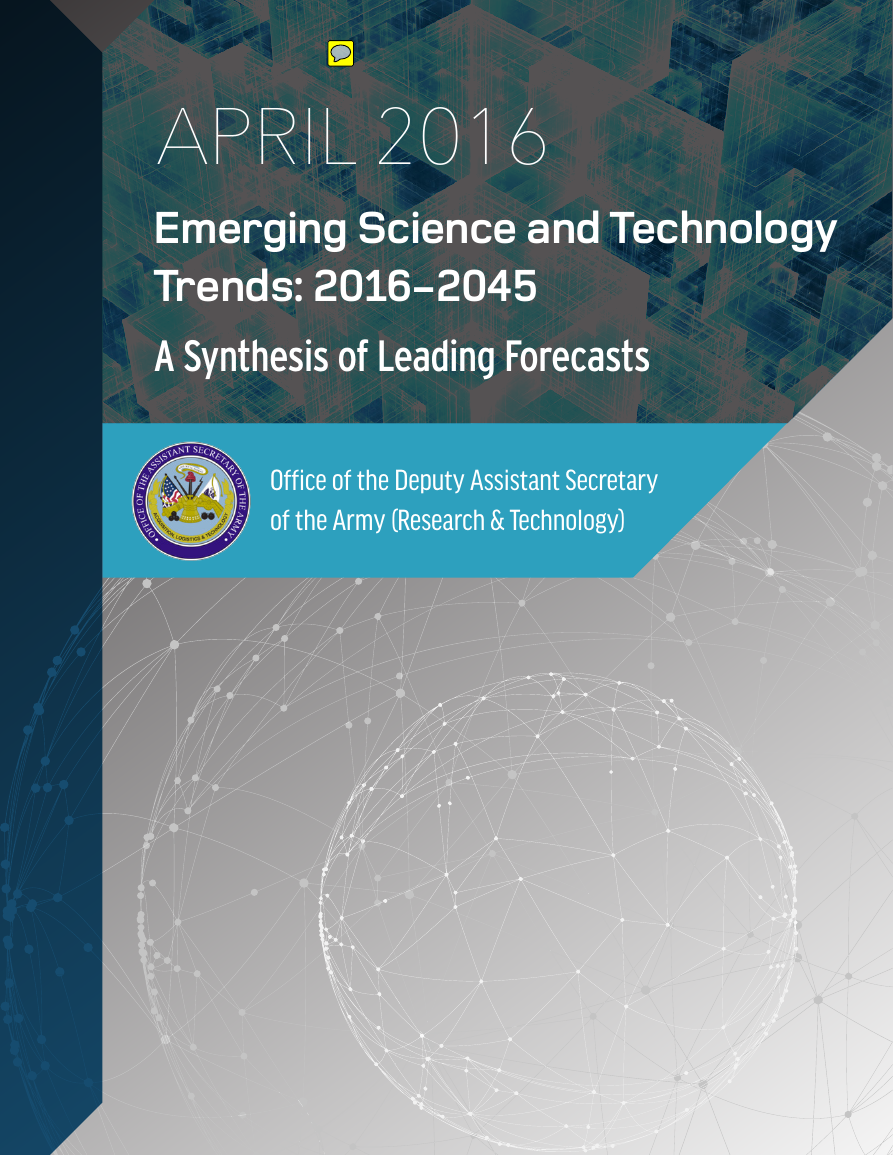
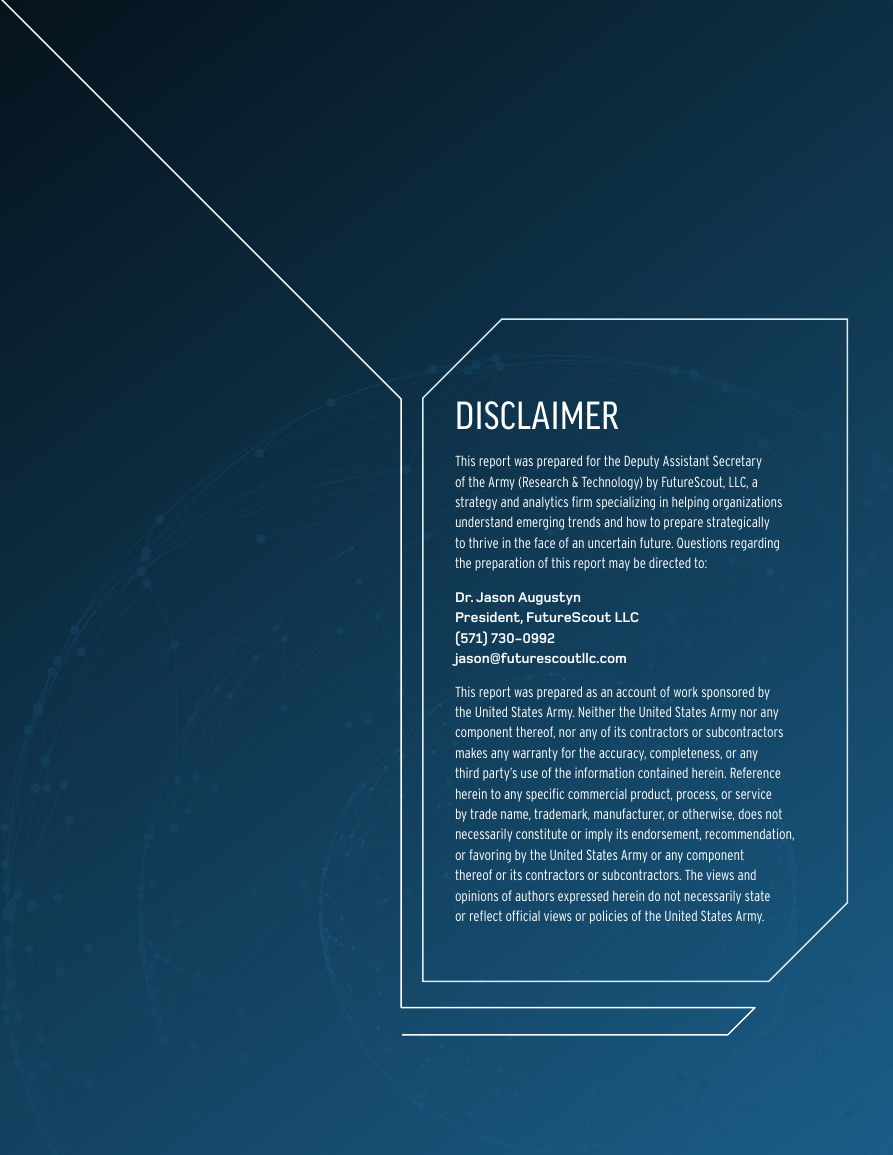

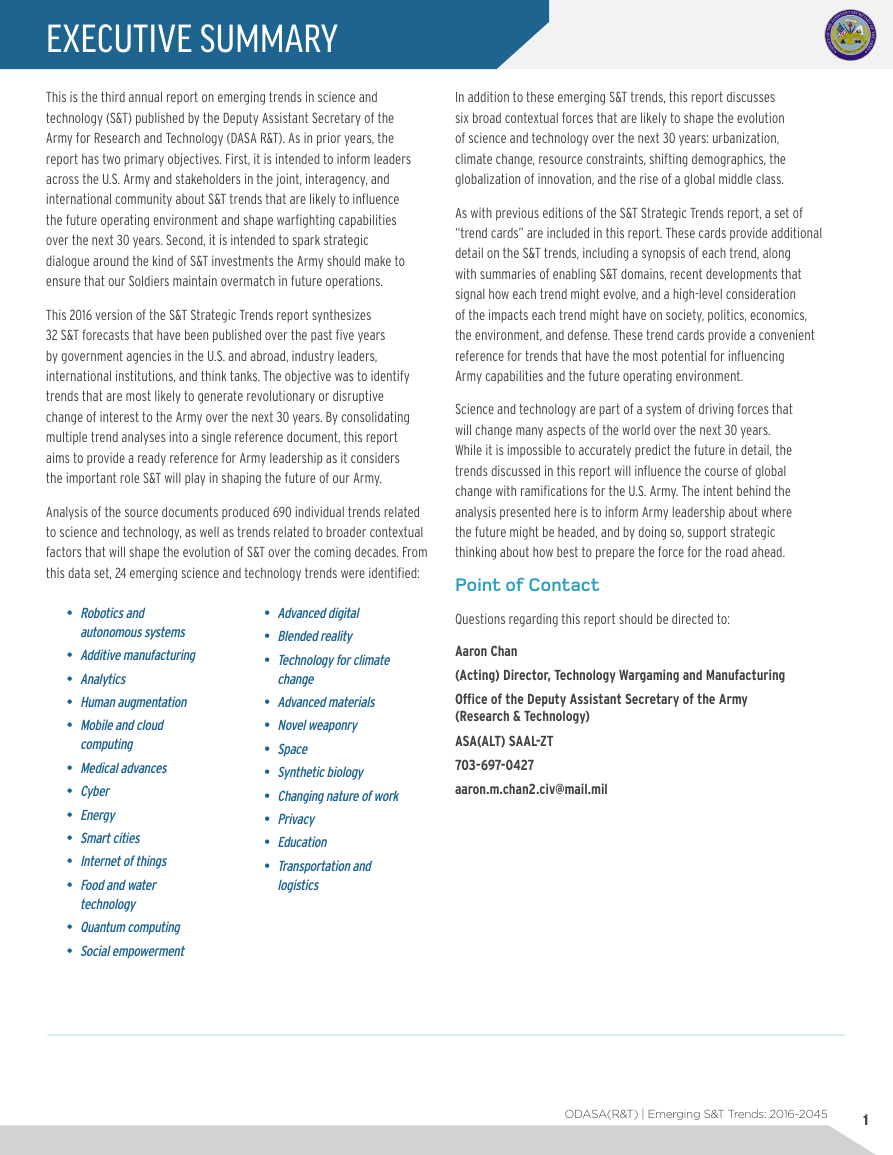
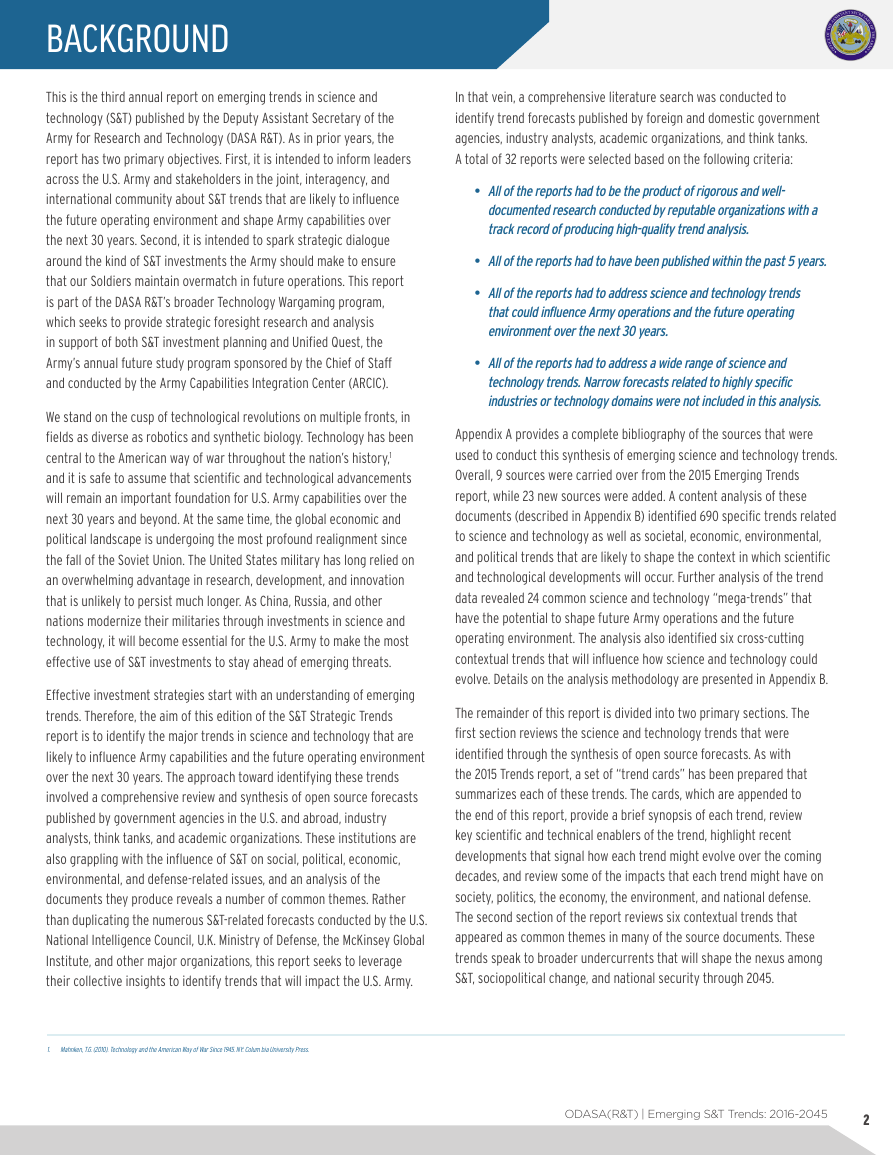
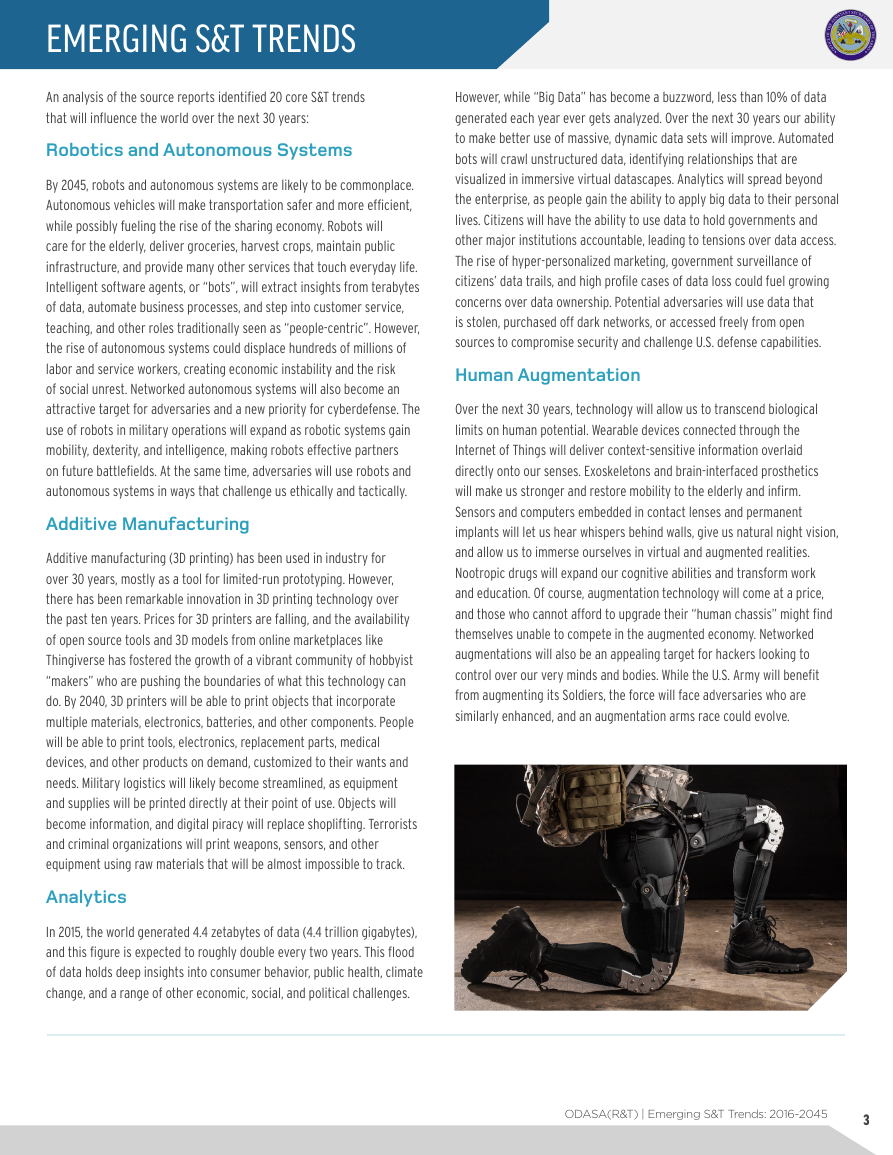
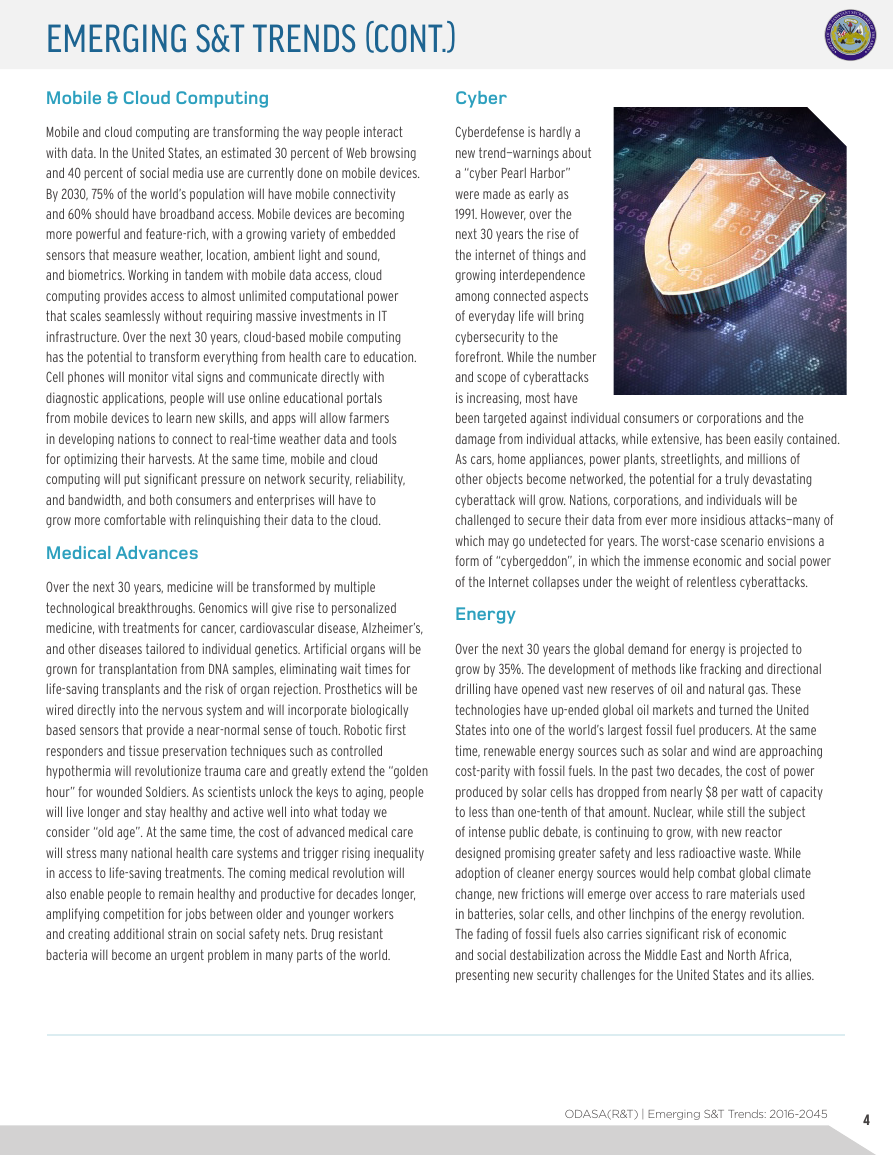









 2023年江西萍乡中考道德与法治真题及答案.doc
2023年江西萍乡中考道德与法治真题及答案.doc 2012年重庆南川中考生物真题及答案.doc
2012年重庆南川中考生物真题及答案.doc 2013年江西师范大学地理学综合及文艺理论基础考研真题.doc
2013年江西师范大学地理学综合及文艺理论基础考研真题.doc 2020年四川甘孜小升初语文真题及答案I卷.doc
2020年四川甘孜小升初语文真题及答案I卷.doc 2020年注册岩土工程师专业基础考试真题及答案.doc
2020年注册岩土工程师专业基础考试真题及答案.doc 2023-2024学年福建省厦门市九年级上学期数学月考试题及答案.doc
2023-2024学年福建省厦门市九年级上学期数学月考试题及答案.doc 2021-2022学年辽宁省沈阳市大东区九年级上学期语文期末试题及答案.doc
2021-2022学年辽宁省沈阳市大东区九年级上学期语文期末试题及答案.doc 2022-2023学年北京东城区初三第一学期物理期末试卷及答案.doc
2022-2023学年北京东城区初三第一学期物理期末试卷及答案.doc 2018上半年江西教师资格初中地理学科知识与教学能力真题及答案.doc
2018上半年江西教师资格初中地理学科知识与教学能力真题及答案.doc 2012年河北国家公务员申论考试真题及答案-省级.doc
2012年河北国家公务员申论考试真题及答案-省级.doc 2020-2021学年江苏省扬州市江都区邵樊片九年级上学期数学第一次质量检测试题及答案.doc
2020-2021学年江苏省扬州市江都区邵樊片九年级上学期数学第一次质量检测试题及答案.doc 2022下半年黑龙江教师资格证中学综合素质真题及答案.doc
2022下半年黑龙江教师资格证中学综合素质真题及答案.doc